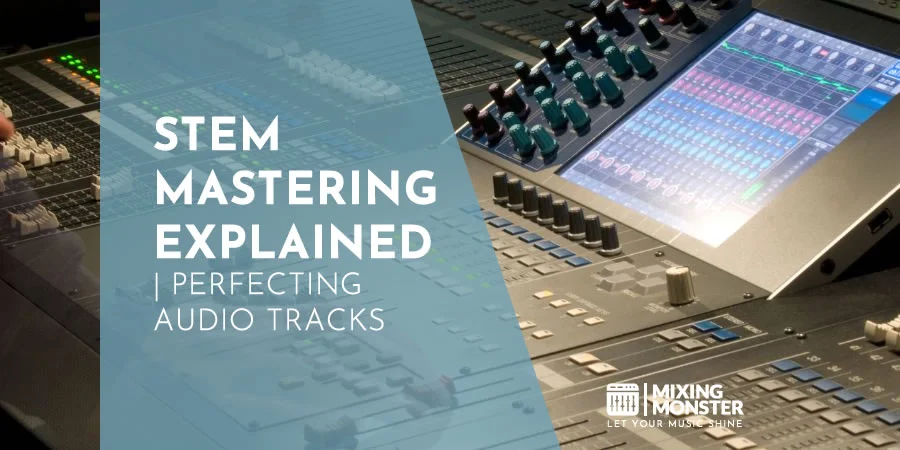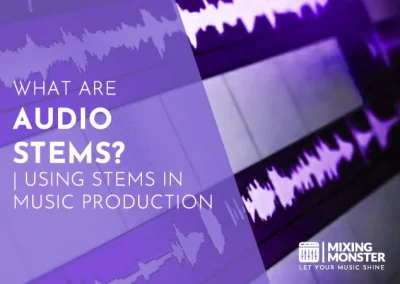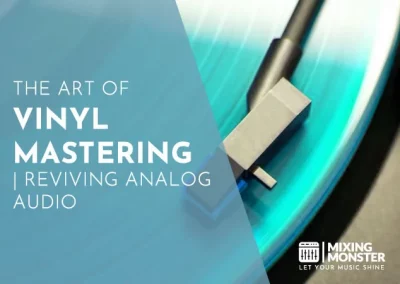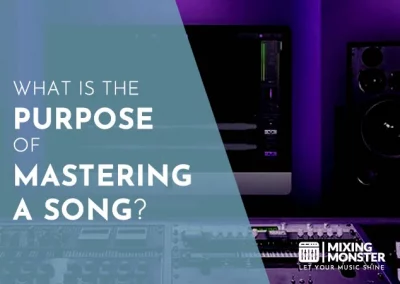Home > Blog > Mastering > Mastering Insights
Disclosure: Some of the links below are affiliate links, meaning that at no additional cost to you, we will receive a commission if you click through and make a purchase. Read our full affiliate disclosure here.
Stem mastering is a nuanced approach to audio mastering. It refines the sound quality of your music in ways stereo mastering might not accommodate.
Stem mastering is a technique that involves processing groups of instruments within a mix separately, known as stems. These stems usually represent significant components of a blend, such as the vocals, bass, drums, and synthesizers. By working with these subdivisions, audio professionals can more precisely enhance the sonic characteristics of each stem, leading to a more detailed and cohesive final master.
Stem mastering is not simply a different technique but a solution providing a greater creative canvas for addressing the balance and blend of a song before it reaches the listener. Delving into stem mastering opens new avenues for tailoring your music’s sound. The attention to detail can turn a good track into a great one, ensuring each element shines at its best. Ready to explore further how stem mastering works and the various aspects and benefits it brings to your audio?
KEY TAKEAWAYS:
- Stem mastering provides detailed control over a mix’s components.
- It offers increased flexibility to address specific elements like vocals and instruments.
- Knowledge of stem mastering is crucial for optimizing the audio quality of your music.
Table Of Contents
1. What Is Stem Mastering?
2. The Technical Aspects Of Stem Mastering
3. The Stem Mastering Process
4. Stem Mastering In The Music Industry
5. Best Practices For Stem Mastering
6. FAQ

1. What Is Stem Mastering?
Stem mastering represents an advanced approach to mastering audio where individual groupings of instruments, known as stems, are separately processed and balanced.
Stem Mastering Explained
In audio production, stems refer to subgroup mixdowns containing one or more related tracks. This could be a drum, vocal, or stem for all the guitars in a mix.
Unlike traditional mastering, which deals with a single stereo track, stem mastering gives the engineer more control over the result by allowing them to adjust and process these discrete mix sections before finally compiling them into a single stereo master.
Stem Mastering Vs. Stereo Mastering
While stereo mastering is the final polish of a singular stereo file, stem mastering requires a more complex setup involving multiple stereo files. Detailed attention to individual elements in the mix is the key point of differentiation.
Here is a quick comparison of the two methods:
| Aspect | Stem Mastering | Traditional (Stereo) Mastering |
|---|---|---|
| Sound Control | More control over individual mix elements | Less control; adjustments affect the mix globally |
| Flexibility | Greater ability to fix mix balance issues | Limited to improvements on the master stereo file |
| Customization | Highly tailored end-product with nuanced adjustments | General enhancements to dynamics and overall sound |
| Complexity | More complex and time-consuming | Simpler and quicker process |
| Cost | Typically more expensive due to detailed work | More cost-effective |
Benefits Of Stem Mastering Over Traditional Mastering
Stem mastering offers significant advantages to the final sound of a recording. One of the main benefits is the granular level of adjustment it affords. Your mixing issues, such as an overpowering bass line or clashing mid-frequencies, can be addressed more precisely.
Additionally, it can introduce new creative possibilities because an engineer can apply different effects or processing to each stem. This leads to a potentially more dynamic and impactful master than traditional mastering, where such individual treatment is impossible.
2. The Technical Aspects Of Stem Mastering
Mastering using stems allows you to manipulate different elements of a mix precisely. This section will guide you through ensuring audio stem quality, applying compression and EQ, and managing volume and dynamic range to achieve the desired sonic fidelity.
Audio Stem Quality Control
Your first step in stem mastering is assessing and controlling the quality of audio stems. Ensure that each stem is an accurate representation of its respective musical component, free from artifacts such as noises and clicks.
Verify that the frequency response is appropriate for the instrument or vocal in the stem and that there is no clipping, which can lead to gain reduction issues later in the process.
Compression And EQ In Stem Mastering
Applying compression to stems should be done judiciously to achieve balance and consistency without compromising the dynamics that give character to the music.
EQ settings are crucial for each stem to ensure frequencies do not clash and each element sits nicely in the mix. Remember, subtle moves can be more effective for shaping the tonal balance of your stems.
Volume And Dynamic Range In Stem Mastering
Stem mastering aims to maintain a healthy volume level and dynamic range across all stems.
While you want to achieve a cohesive sound, avoid squashing the dynamics too much, which can lead to a lifeless final product. It’s a delicate balance between maintaining loudness and preserving the natural push and pull of the performance.
3. The Stem Mastering Process
Stem mastering bridges the gap between mixing and mastering, allowing you to fine-tune specific elements of your track for a polished final product.
Flexible Control And Adjustments
During stem mastering, you retain a higher degree of control over the separate elements of your mix. Instead of dealing with a single stereo file, you can access stems—submixes of similar instruments or sounds.
This setup allows you to make targeted adjustments, such as correcting the level of a background vocal without affecting the main vocal.
Achieving Balance And Clarity In Stem Mastering
Separating instruments into stems allows one to achieve a more balanced and clear sound. For instance, if the bass overpowers the kick drum, you can modify the bass stem, ensuring both elements sit well in the mix without compromise.
Spatial Enhancements And Stereo Imaging In Stem Mastering
Working with stems significantly improves your ability to enhance stereo imaging.
You can precisely apply stereo widening techniques by isolating elements like lead guitar or keyboards. This makes the mix sound expansive and immersive without causing phase issues that can arise from processing a complete stereo file.
How To Master With Stems
To master effectively with stems, follow these steps:
- Organize your stems logically, grouping similar sounds.
- Apply EQ and compression to each stem as needed, ensuring consistency and control over the dynamics.
- Adjust the levels of each stem to achieve the desired balance.
- Enhance the stereo image of individual stems without compromising the overall mix.
- Use subtle reverbs and spatial effects to add depth selectively.
- Listen to the interactions between stems, making incremental changes for a cohesive sound.
- Finally, check your main on different sound systems to ensure they translate well.
4. Stem Mastering In The Music Industry
Stem mastering, a nuanced approach in audio production, gives you more control over the final sound. This practice has been well-embraced in the music industry to ensure high-quality music deliverables.
Stem Mastering Popularity
Stem mastering is gaining traction as a preferred method of finalizing a mix before distribution. Many mixing engineers advocate for its use due to its flexibility in applying changes to individual aspects of a track.
Stem files and sub-mixes like vocals or drums allow finer adjustments during mastering, which can’t be done with stereo mixdown. This flexibility is particularly valued in genres dense with layers and nuances, such as pop, where pristine audio delivery is critical.
- Why Choose Stem Mastering:
- Better control over individual elements.
- Improved end quality of the track.
- Where It’s Most Beneficial:
- Genres with complex layering.
- Tracks requiring precise adjustments post-mix.
Stem Mastering Chains And Tools
In stem mastering, the mastering chain is critical. You’ll typically use a range of plugins to tweak each stem file, with common tools including equalizers, compressors, limiters, and more advanced spatial effects.
A vital part of the audio production process is ensuring that these tools process the music appropriately, keeping the original dynamics and character intact.
Remember that each stem is processed individually before being combined into the final master, allowing for a polished and cohesive sound.
- Typical Mastering Chain Tools:
- EQ:
To balance frequencies. - Compression:
To control dynamics. - Limiting:
To ensure consistent volume levels. - Key Considerations:
- Maintain the track’s original character.
- Avoid over-processing to prevent loss of dynamics

5. Best Practices For Stem Mastering
When approaching stem mastering, precise preparation of your mix session and understanding the common pitfalls are essential. Pay attention to each audio track’s role in the final stereo master and your collaboration with the mastering engineer.
Preparing Your Mix For Stem Mastering
Before sending off your stems, ensure they’ve been adequately prepared.
Start with gain staging to keep levels consistent and prevent clipping. Then, maintain sufficient dynamic range. Avoid over-compressing or limiting your stems, as doing so can strip away the mix’s nuance.
Next, tidy up each audio track, label them clearly, and double-check for residual noises that may compromise the reverb quality and other effects.
- Check Each Stem:
- Levels are consistent
- No clipping
- Dynamic range is ample
- Clear labeling
Stem Mastering Mistakes And Solutions
The most common mistake in stem mastering is over-processing before sending stems to a mix engineer. If you’ve saturated or compressed excessively, the engineer needs more flexibility to shape the sound.
If this occurs, revisit your mix session, dial back on the effects, and aim for a more balanced, neutral sound. Always remember to leave the mastering engineer room to apply a final polish.
- Over-Processing Signs:
- Lack of dynamic range
- Unwanted distortion
- Reduced flexibility during mastering
The Dynamics Of Stem Mastering Collaboration
Your professional bond with the mastering engineer is crucial. Communicate your vision clearly, and be open to feedback.
Working with dynamics considers the threshold of compression and limiters you have placed on your stems. Ensuring these are set appropriately avoids squashing the mix and allows the engineer to enhance the track’s clarity and punch.
- To Optimize Collaboration:
- Share your vision and goals
- Be receptive to feedback
- Discuss dynamics and threshold settings
Wrapping Up Stem Mastering
Once your stems are neatly packaged and sent and you’ve touched base with the mastering engineer, your role in the stem mastering process is nearly complete.
Revisit the stems you’ve provided, and ensure no unnoticed issues such as phasing from stereo effects or a mix engineer’s overlooked mistakes.
Clean, well-arranged stems are the foundation of an exceptional stem-mastering outcome.
Final Checks:
-
- No phase issues
- No overlooked mistakes
- Stems arranged for easy navigation
Happy stem mastering!
6. FAQ
1) What are the benefits of stem mastering over stereo mastering?
Stem mastering provides more flexibility than stereo mastering. It allows the engineer to adjust the balance and tone of each group of instruments separately. This can result in a clearer mix and more detailed soundstage, as problems can be resolved within each stem rather than the mix as a whole.
2) How does the stem mastering process differ from traditional mastering?
Unlike traditional mastering, which works with a final stereo mix, stem mastering involves working with multiple stems, which are submixes of instruments or vocals. Each stem can be processed separately, providing more possibilities for enhancement and correction before combining them into a final master.
3) What should I consider when choosing stem mastering services?
When selecting stem mastering services, consider the engineer’s experience, their mastering portfolio, the genres they specialize in, and client testimonials. Also, look for clear communication about your expectations regarding stem preparation and delivery.
4) How much does professional stem mastering typically cost?
The cost of professional stem mastering can vary widely, depending on the engineer’s reputation and location, the project’s complexity, and the number of stems. Prices range from a modest fee per song to several hundred dollars for a full album.
5) What file format and quality are required when submitting stems for mastering?
High-resolution audio files, typically 24-bit WAV or AIFF formats, are preferred. Ensure that your stems are consolidated and labeled clearly and that no clipping occurs. A around -6dB headroom is ideal to allow the mastering engineer space to work.
6) Can stem mastering improve the overall sound quality of a mixed track?
Yes, stem mastering can significantly enhance the sound quality of a track. It allows us to fine-tune individual elements, correct issues, and achieve a polished, coherent final product. This final product sounds great on a wide array of playback systems.



















